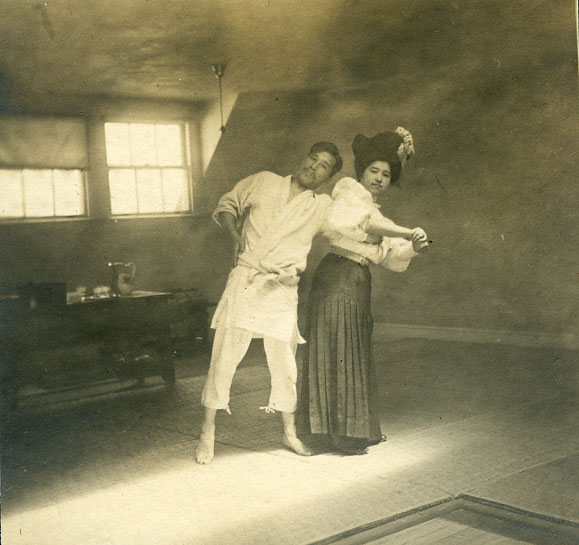Background on Yoshiaki Yamashita

Yoshiaki and Fude Yamashita, ca.1904
Seeking to strengthen his nine-year old son's "character," Samuel Hill sought out a suitable man to provide instruction in an exotic art he had seen during a business trip to Japan: judo. A wealthy Seattle railroad executive, Hill had the contacts -- and funds -- to hire the best and in February 1903, Kazuyoshi Shibata, a Yale student and friend of a Japanese acquaintance, recommended Professor Yoshiaki (Yoshigutsu) Yamashita as the best man for the manly job.
Born in Ishikawa Prefecture on Feb. 16, 1865, the son of a minor samurai, Yamashita had a basic grounding in the traditional martial arts before joining the new Kodokan dojo of Jigoro Kano, the founder of judo, in August 1884. Yamashita rose steadily, even rapidly, through the ranks, achieving his sixth degree black belt in 1898 and gaining wide respect for his technical mastery. By the turn of the century, his reputation earned him a position teaching judo at the Japanese Naval Academy and Tokyo Imperial University.
Having long believed that making judo better known abroad would be good for Japan, Yamashita was an outstanding choice to spread the discipline in America, and he quickly responded to Hill's inquiry. Accepting the offer in August 1903, Yamashita sailed for Seattle the following month, bringing with him his wife, Fude, and a 19-year old assistant, Saburo Kawaguchi. Barely a week after their arrival, the trio gave a private judo exhibition for Hill and prominent invited guests, which historian Joseph Svinth believes may have been the first Kodokan judo exhibition for a non-Japanese audience in North America.
From Seattle, Yamashita and his party traveled across country by rail to Washington, D.C., where Hill's son, John Nathan Hill, was then living. Offering demonstrations and lessons through the Japanese Legation, Yamashita found an eager audience of students in the nation's capitol, and a surprisingly strong interest among the daughters of the nation's political and corporate elite. Among the many who took notice was the President, Theodore Roosevelt, who had a well-known passion for what he considered manly pursuits. Through the Japanese Naval Attaché, Isamu Takeshita, Yamashita was introduced to Roosevelt at the White House in 1904 and by the spring, he had Roosevelt adding judo to his regular fitness regimen.
In January 1905, Yamashita left Washington to accept a position instructing midshipmen at the U.S. Naval Academy in Annapolis, Maryland. At the same time, representatives of the Army visited Annapolis to investigate the potential of Japanese martial arts, but while these representatives were favorably impressed, the Academy opted instead to hire a wrestling champion to train the cadets, a man who preferred the traditional western sports of boxing and wrestling.
From this point forward, Yamashita's American sojourn wound down. His contract with the Naval Academy was not renewed for the fall 1905, but after Roosevelt personally intervened, Superintendent James H. Sands agreed to rehire him for another year. At the end of this second term, however, Sands recommended that the judo program be discontinued as not essential to shipboard life. Yamashita returned to Japan in the fall 1906 and continued to teach judo until his death on October 26, 1935. He was posthumously awarded the 10th degree black belt, the first ever so honored.









![Uchi mata (rotation [arrow]), linking to the digital object](http://credo.library.umass.edu/images/resize/300/muph006-b001-i009-001.png)




![Yoko gake [photo loose, laid into album], linking to the digital object](http://credo.library.umass.edu/images/resize/300/muph006-b001-i014-001.png)




























![[Uchi konei] (b), linking to the digital object](http://credo.library.umass.edu/images/resize/300/muph006-b001-i043-001.png)




![[unidentified throw], linking to the digital object](http://credo.library.umass.edu/images/resize/300/muph006-b001-i048-001.png)
![[unidentified kick], linking to the digital object](http://credo.library.umass.edu/images/resize/300/muph006-b001-i049-001.png)
![[unidentified throw], linking to the digital object](http://credo.library.umass.edu/images/resize/300/muph006-b001-i050-001.png)
![[Prof. Yamashita, Mrs. Yamashita, unidentified American], linking to the digital object](http://credo.library.umass.edu/images/resize/300/muph006-b001-i051-001.png)
![[Prof. Yamashita seated between unidentified Americans], linking to the digital object](http://credo.library.umass.edu/images/resize/300/muph006-b001-i052-001.png)
![[Prof. Yamashita seated between unidentified Americans], linking to the digital object](http://credo.library.umass.edu/images/resize/300/muph006-b001-i053-001.png)
